LSC Malta: Kellogg's Dividend Policy - An Internal Management Report
VerifiedAdded on 2023/03/23
|11
|2754
|36
Report
AI Summary
This report, prepared for Kellogg's CFO, delves into the company's dividend policy and its significance. It reviews Kellogg's dividend performance over the past five years, highlighting the increasing dividend trend despite fluctuations in net income and payout ratios. The report also outlines major dividend policy theories, including the Modigliani-Miller theory, Walter's model, and Gordon's model, discussing their assumptions and implications. Ultimately, the report aims to inform a discussion with major shareholders and recommend a future dividend policy that balances shareholder satisfaction with the company's financial health and growth prospects. This document is available on Desklib, a platform offering a wide range of study resources, including past papers and solved assignments, for students.
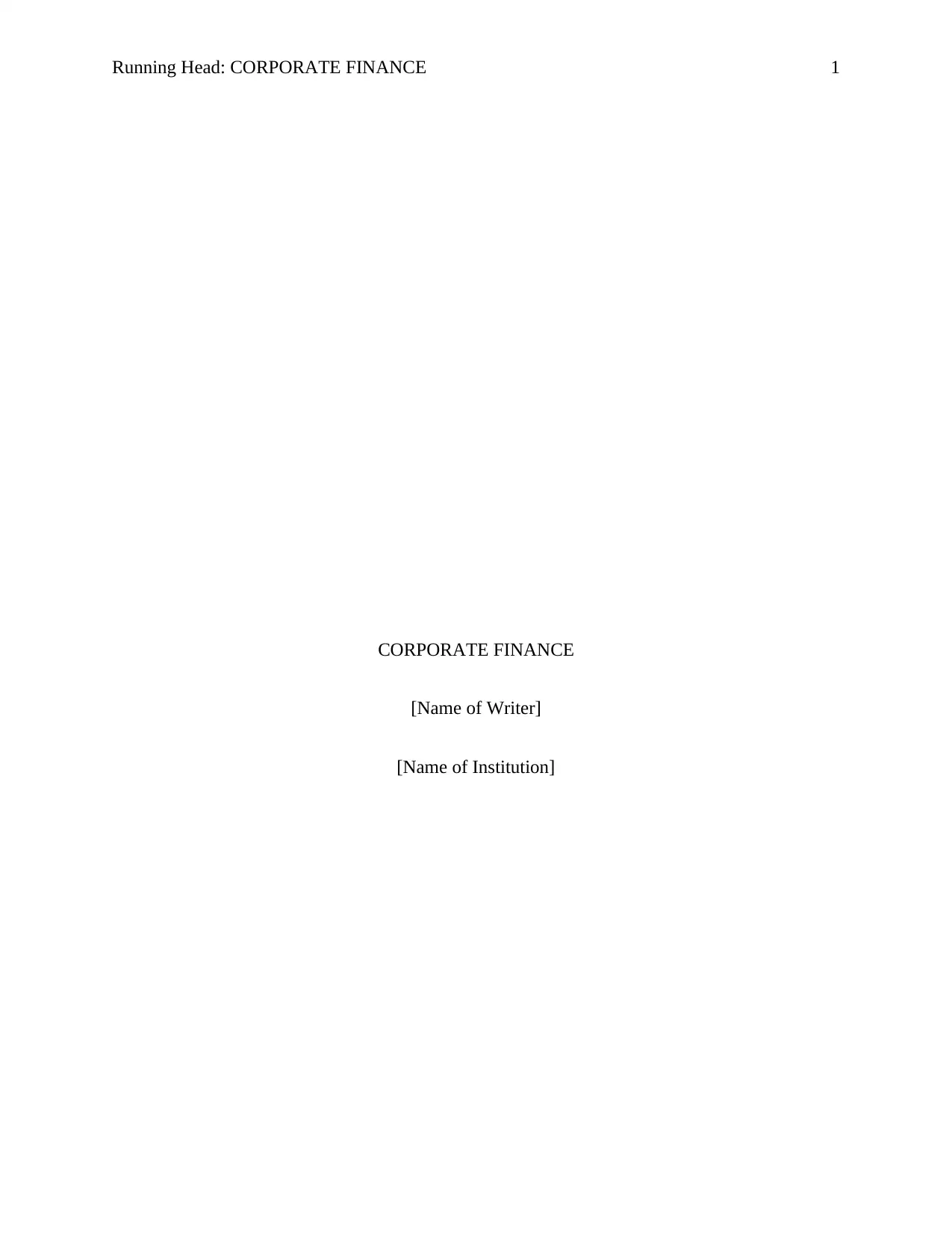
Running Head: CORPORATE FINANCE 1
CORPORATE FINANCE
[Name of Writer]
[Name of Institution]
CORPORATE FINANCE
[Name of Writer]
[Name of Institution]
Paraphrase This Document
Need a fresh take? Get an instant paraphrase of this document with our AI Paraphraser
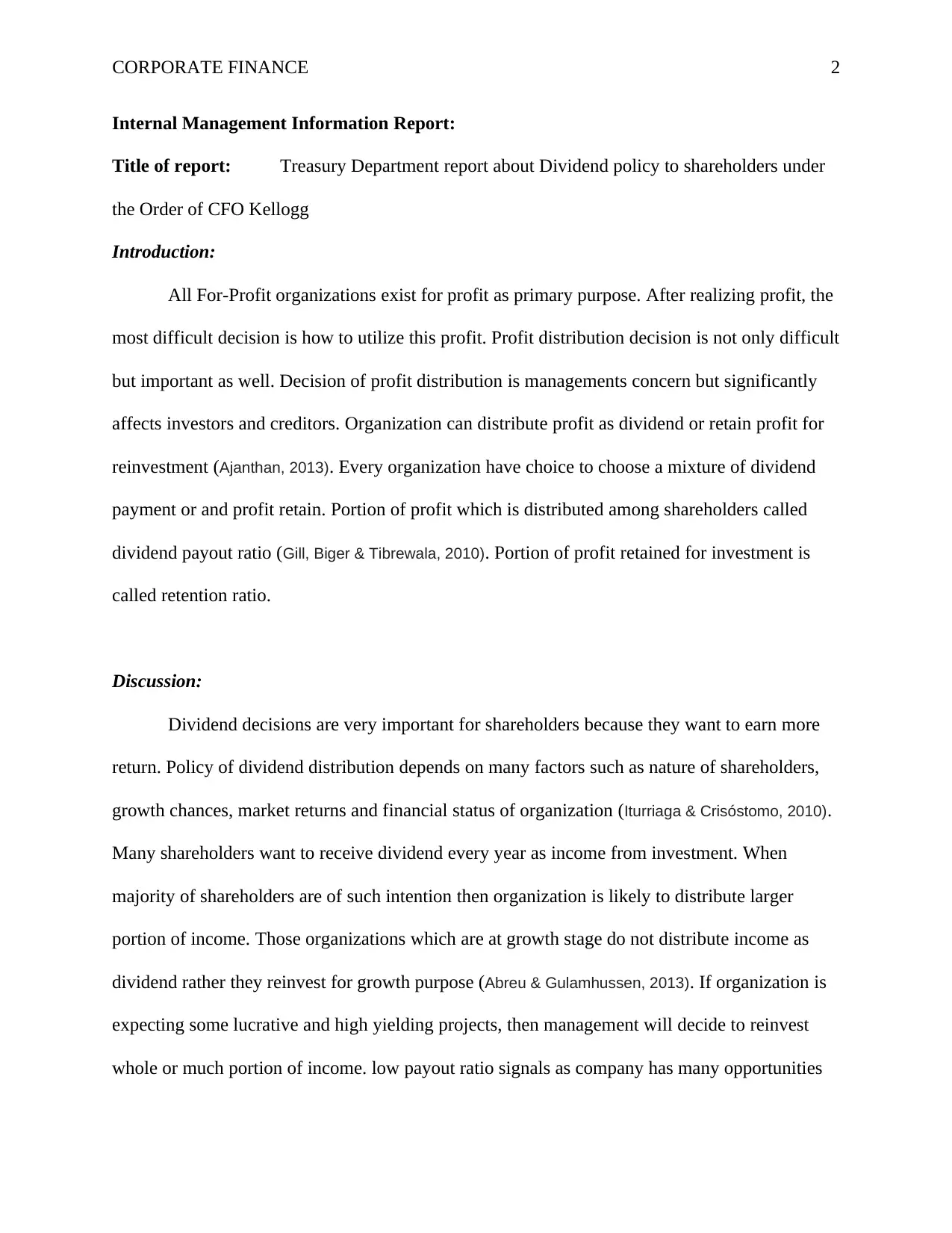
CORPORATE FINANCE 2
Internal Management Information Report:
Title of report: Treasury Department report about Dividend policy to shareholders under
the Order of CFO Kellogg
Introduction:
All For-Profit organizations exist for profit as primary purpose. After realizing profit, the
most difficult decision is how to utilize this profit. Profit distribution decision is not only difficult
but important as well. Decision of profit distribution is managements concern but significantly
affects investors and creditors. Organization can distribute profit as dividend or retain profit for
reinvestment (Ajanthan, 2013). Every organization have choice to choose a mixture of dividend
payment or and profit retain. Portion of profit which is distributed among shareholders called
dividend payout ratio (Gill, Biger & Tibrewala, 2010). Portion of profit retained for investment is
called retention ratio.
Discussion:
Dividend decisions are very important for shareholders because they want to earn more
return. Policy of dividend distribution depends on many factors such as nature of shareholders,
growth chances, market returns and financial status of organization (Iturriaga & Crisóstomo, 2010).
Many shareholders want to receive dividend every year as income from investment. When
majority of shareholders are of such intention then organization is likely to distribute larger
portion of income. Those organizations which are at growth stage do not distribute income as
dividend rather they reinvest for growth purpose (Abreu & Gulamhussen, 2013). If organization is
expecting some lucrative and high yielding projects, then management will decide to reinvest
whole or much portion of income. low payout ratio signals as company has many opportunities
Internal Management Information Report:
Title of report: Treasury Department report about Dividend policy to shareholders under
the Order of CFO Kellogg
Introduction:
All For-Profit organizations exist for profit as primary purpose. After realizing profit, the
most difficult decision is how to utilize this profit. Profit distribution decision is not only difficult
but important as well. Decision of profit distribution is managements concern but significantly
affects investors and creditors. Organization can distribute profit as dividend or retain profit for
reinvestment (Ajanthan, 2013). Every organization have choice to choose a mixture of dividend
payment or and profit retain. Portion of profit which is distributed among shareholders called
dividend payout ratio (Gill, Biger & Tibrewala, 2010). Portion of profit retained for investment is
called retention ratio.
Discussion:
Dividend decisions are very important for shareholders because they want to earn more
return. Policy of dividend distribution depends on many factors such as nature of shareholders,
growth chances, market returns and financial status of organization (Iturriaga & Crisóstomo, 2010).
Many shareholders want to receive dividend every year as income from investment. When
majority of shareholders are of such intention then organization is likely to distribute larger
portion of income. Those organizations which are at growth stage do not distribute income as
dividend rather they reinvest for growth purpose (Abreu & Gulamhussen, 2013). If organization is
expecting some lucrative and high yielding projects, then management will decide to reinvest
whole or much portion of income. low payout ratio signals as company has many opportunities
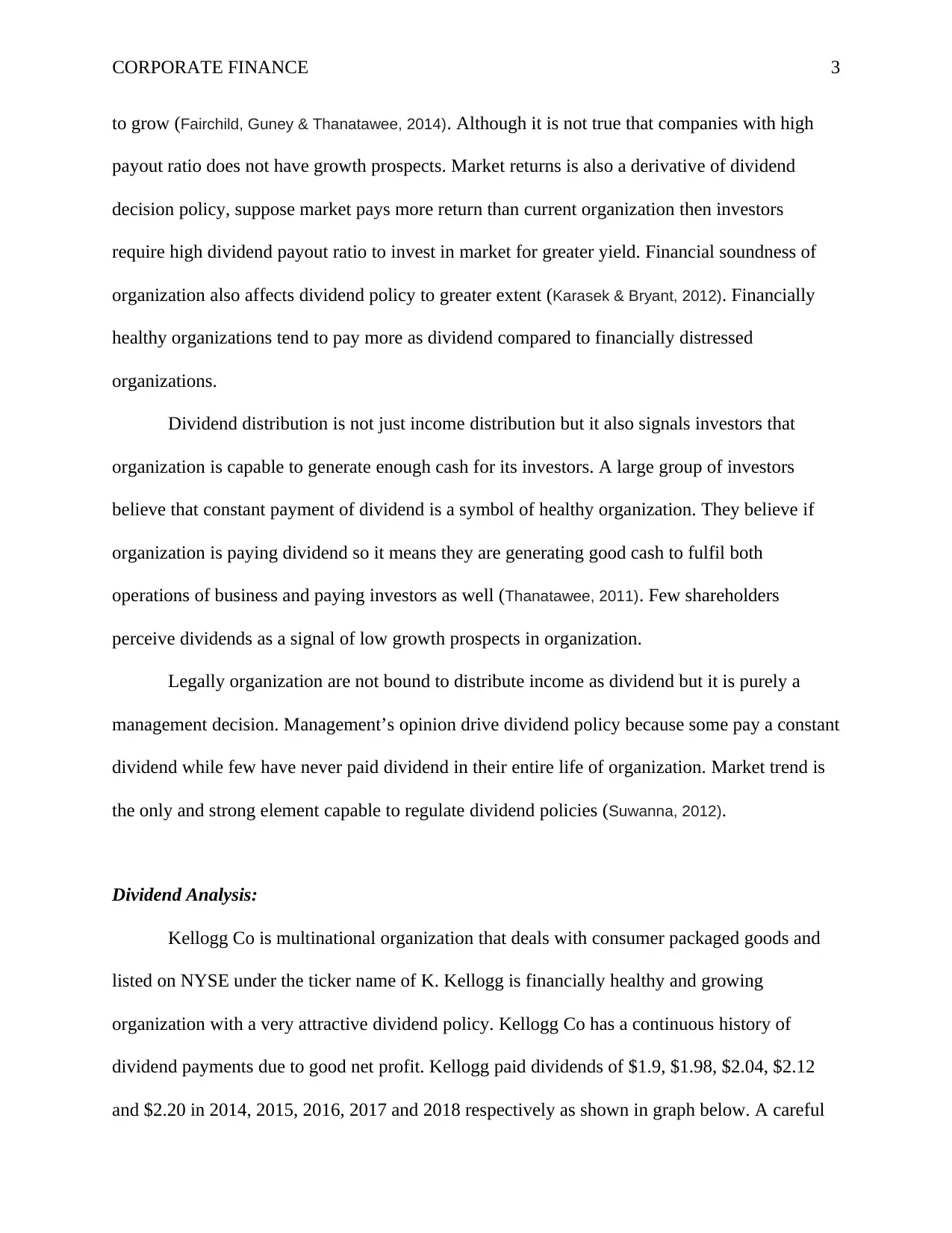
CORPORATE FINANCE 3
to grow (Fairchild, Guney & Thanatawee, 2014). Although it is not true that companies with high
payout ratio does not have growth prospects. Market returns is also a derivative of dividend
decision policy, suppose market pays more return than current organization then investors
require high dividend payout ratio to invest in market for greater yield. Financial soundness of
organization also affects dividend policy to greater extent (Karasek & Bryant, 2012). Financially
healthy organizations tend to pay more as dividend compared to financially distressed
organizations.
Dividend distribution is not just income distribution but it also signals investors that
organization is capable to generate enough cash for its investors. A large group of investors
believe that constant payment of dividend is a symbol of healthy organization. They believe if
organization is paying dividend so it means they are generating good cash to fulfil both
operations of business and paying investors as well (Thanatawee, 2011). Few shareholders
perceive dividends as a signal of low growth prospects in organization.
Legally organization are not bound to distribute income as dividend but it is purely a
management decision. Management’s opinion drive dividend policy because some pay a constant
dividend while few have never paid dividend in their entire life of organization. Market trend is
the only and strong element capable to regulate dividend policies (Suwanna, 2012).
Dividend Analysis:
Kellogg Co is multinational organization that deals with consumer packaged goods and
listed on NYSE under the ticker name of K. Kellogg is financially healthy and growing
organization with a very attractive dividend policy. Kellogg Co has a continuous history of
dividend payments due to good net profit. Kellogg paid dividends of $1.9, $1.98, $2.04, $2.12
and $2.20 in 2014, 2015, 2016, 2017 and 2018 respectively as shown in graph below. A careful
to grow (Fairchild, Guney & Thanatawee, 2014). Although it is not true that companies with high
payout ratio does not have growth prospects. Market returns is also a derivative of dividend
decision policy, suppose market pays more return than current organization then investors
require high dividend payout ratio to invest in market for greater yield. Financial soundness of
organization also affects dividend policy to greater extent (Karasek & Bryant, 2012). Financially
healthy organizations tend to pay more as dividend compared to financially distressed
organizations.
Dividend distribution is not just income distribution but it also signals investors that
organization is capable to generate enough cash for its investors. A large group of investors
believe that constant payment of dividend is a symbol of healthy organization. They believe if
organization is paying dividend so it means they are generating good cash to fulfil both
operations of business and paying investors as well (Thanatawee, 2011). Few shareholders
perceive dividends as a signal of low growth prospects in organization.
Legally organization are not bound to distribute income as dividend but it is purely a
management decision. Management’s opinion drive dividend policy because some pay a constant
dividend while few have never paid dividend in their entire life of organization. Market trend is
the only and strong element capable to regulate dividend policies (Suwanna, 2012).
Dividend Analysis:
Kellogg Co is multinational organization that deals with consumer packaged goods and
listed on NYSE under the ticker name of K. Kellogg is financially healthy and growing
organization with a very attractive dividend policy. Kellogg Co has a continuous history of
dividend payments due to good net profit. Kellogg paid dividends of $1.9, $1.98, $2.04, $2.12
and $2.20 in 2014, 2015, 2016, 2017 and 2018 respectively as shown in graph below. A careful
⊘ This is a preview!⊘
Do you want full access?
Subscribe today to unlock all pages.

Trusted by 1+ million students worldwide
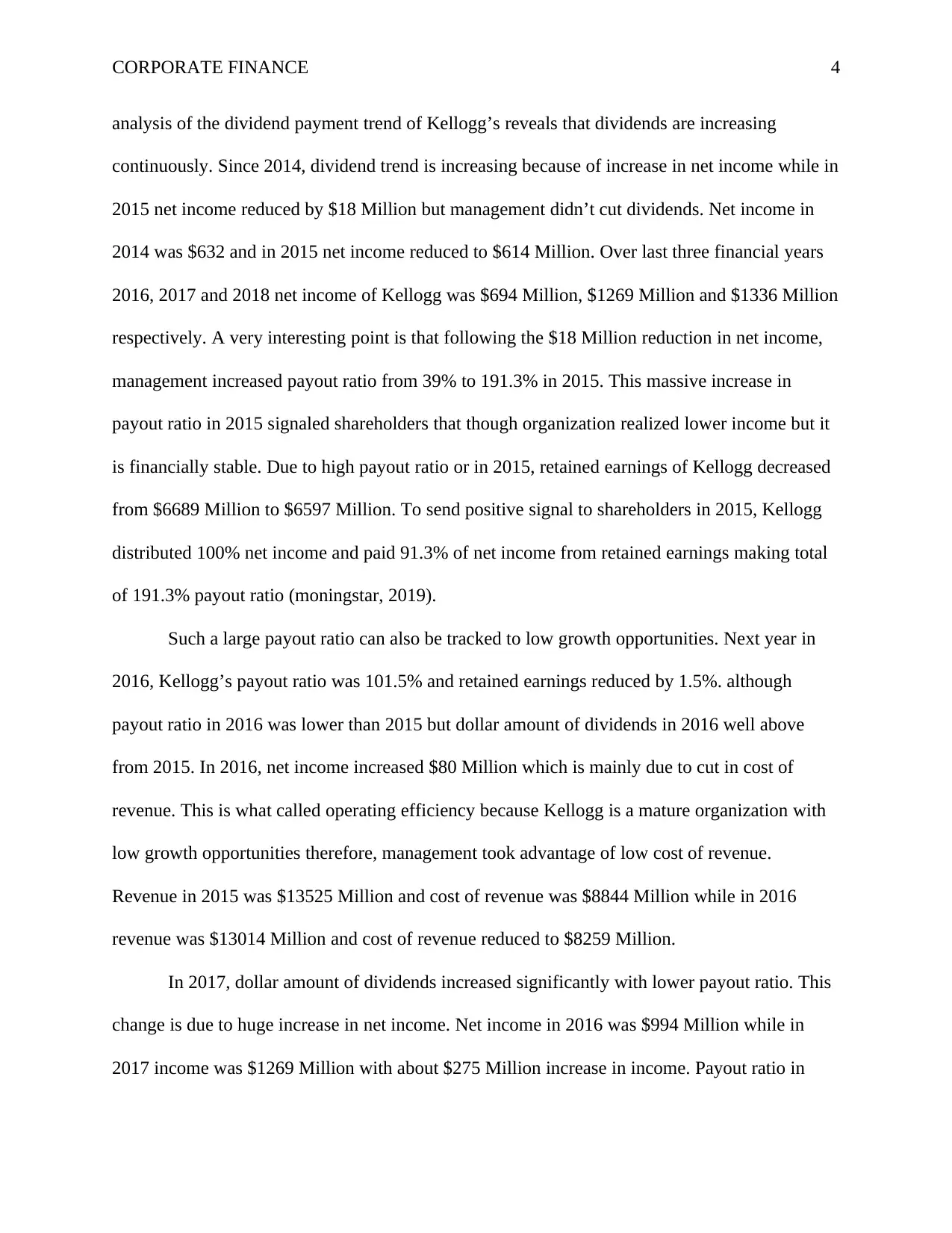
CORPORATE FINANCE 4
analysis of the dividend payment trend of Kellogg’s reveals that dividends are increasing
continuously. Since 2014, dividend trend is increasing because of increase in net income while in
2015 net income reduced by $18 Million but management didn’t cut dividends. Net income in
2014 was $632 and in 2015 net income reduced to $614 Million. Over last three financial years
2016, 2017 and 2018 net income of Kellogg was $694 Million, $1269 Million and $1336 Million
respectively. A very interesting point is that following the $18 Million reduction in net income,
management increased payout ratio from 39% to 191.3% in 2015. This massive increase in
payout ratio in 2015 signaled shareholders that though organization realized lower income but it
is financially stable. Due to high payout ratio or in 2015, retained earnings of Kellogg decreased
from $6689 Million to $6597 Million. To send positive signal to shareholders in 2015, Kellogg
distributed 100% net income and paid 91.3% of net income from retained earnings making total
of 191.3% payout ratio (moningstar, 2019).
Such a large payout ratio can also be tracked to low growth opportunities. Next year in
2016, Kellogg’s payout ratio was 101.5% and retained earnings reduced by 1.5%. although
payout ratio in 2016 was lower than 2015 but dollar amount of dividends in 2016 well above
from 2015. In 2016, net income increased $80 Million which is mainly due to cut in cost of
revenue. This is what called operating efficiency because Kellogg is a mature organization with
low growth opportunities therefore, management took advantage of low cost of revenue.
Revenue in 2015 was $13525 Million and cost of revenue was $8844 Million while in 2016
revenue was $13014 Million and cost of revenue reduced to $8259 Million.
In 2017, dollar amount of dividends increased significantly with lower payout ratio. This
change is due to huge increase in net income. Net income in 2016 was $994 Million while in
2017 income was $1269 Million with about $275 Million increase in income. Payout ratio in
analysis of the dividend payment trend of Kellogg’s reveals that dividends are increasing
continuously. Since 2014, dividend trend is increasing because of increase in net income while in
2015 net income reduced by $18 Million but management didn’t cut dividends. Net income in
2014 was $632 and in 2015 net income reduced to $614 Million. Over last three financial years
2016, 2017 and 2018 net income of Kellogg was $694 Million, $1269 Million and $1336 Million
respectively. A very interesting point is that following the $18 Million reduction in net income,
management increased payout ratio from 39% to 191.3% in 2015. This massive increase in
payout ratio in 2015 signaled shareholders that though organization realized lower income but it
is financially stable. Due to high payout ratio or in 2015, retained earnings of Kellogg decreased
from $6689 Million to $6597 Million. To send positive signal to shareholders in 2015, Kellogg
distributed 100% net income and paid 91.3% of net income from retained earnings making total
of 191.3% payout ratio (moningstar, 2019).
Such a large payout ratio can also be tracked to low growth opportunities. Next year in
2016, Kellogg’s payout ratio was 101.5% and retained earnings reduced by 1.5%. although
payout ratio in 2016 was lower than 2015 but dollar amount of dividends in 2016 well above
from 2015. In 2016, net income increased $80 Million which is mainly due to cut in cost of
revenue. This is what called operating efficiency because Kellogg is a mature organization with
low growth opportunities therefore, management took advantage of low cost of revenue.
Revenue in 2015 was $13525 Million and cost of revenue was $8844 Million while in 2016
revenue was $13014 Million and cost of revenue reduced to $8259 Million.
In 2017, dollar amount of dividends increased significantly with lower payout ratio. This
change is due to huge increase in net income. Net income in 2016 was $994 Million while in
2017 income was $1269 Million with about $275 Million increase in income. Payout ratio in
Paraphrase This Document
Need a fresh take? Get an instant paraphrase of this document with our AI Paraphraser
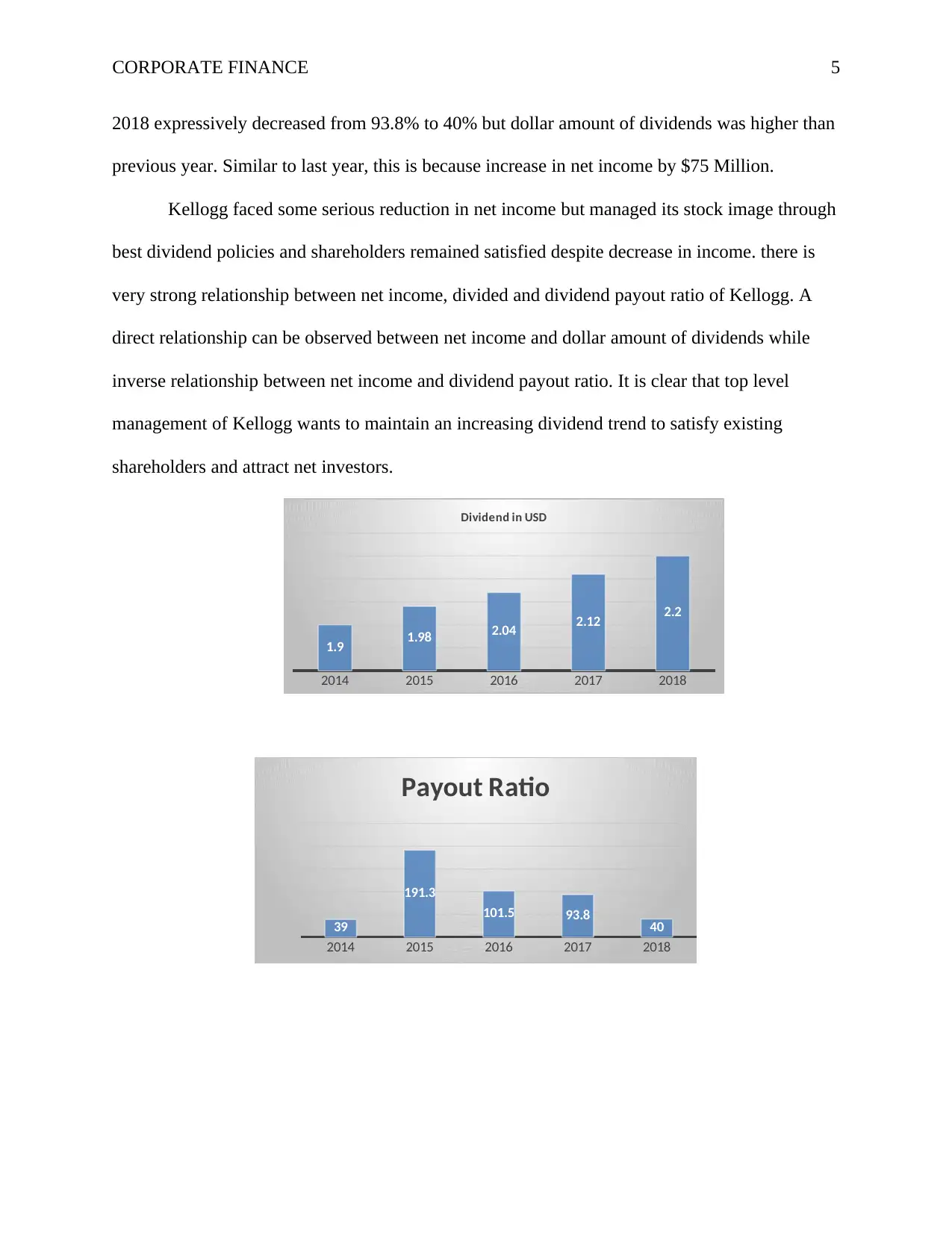
CORPORATE FINANCE 5
2018 expressively decreased from 93.8% to 40% but dollar amount of dividends was higher than
previous year. Similar to last year, this is because increase in net income by $75 Million.
Kellogg faced some serious reduction in net income but managed its stock image through
best dividend policies and shareholders remained satisfied despite decrease in income. there is
very strong relationship between net income, divided and dividend payout ratio of Kellogg. A
direct relationship can be observed between net income and dollar amount of dividends while
inverse relationship between net income and dividend payout ratio. It is clear that top level
management of Kellogg wants to maintain an increasing dividend trend to satisfy existing
shareholders and attract net investors.
2014 2015 2016 2017 2018
1.9 1.98 2.04 2.12 2.2
Dividend in USD
2014 2015 2016 2017 2018
39
191.3
101.5 93.8 40
Payout Ratio
2018 expressively decreased from 93.8% to 40% but dollar amount of dividends was higher than
previous year. Similar to last year, this is because increase in net income by $75 Million.
Kellogg faced some serious reduction in net income but managed its stock image through
best dividend policies and shareholders remained satisfied despite decrease in income. there is
very strong relationship between net income, divided and dividend payout ratio of Kellogg. A
direct relationship can be observed between net income and dollar amount of dividends while
inverse relationship between net income and dividend payout ratio. It is clear that top level
management of Kellogg wants to maintain an increasing dividend trend to satisfy existing
shareholders and attract net investors.
2014 2015 2016 2017 2018
1.9 1.98 2.04 2.12 2.2
Dividend in USD
2014 2015 2016 2017 2018
39
191.3
101.5 93.8 40
Payout Ratio
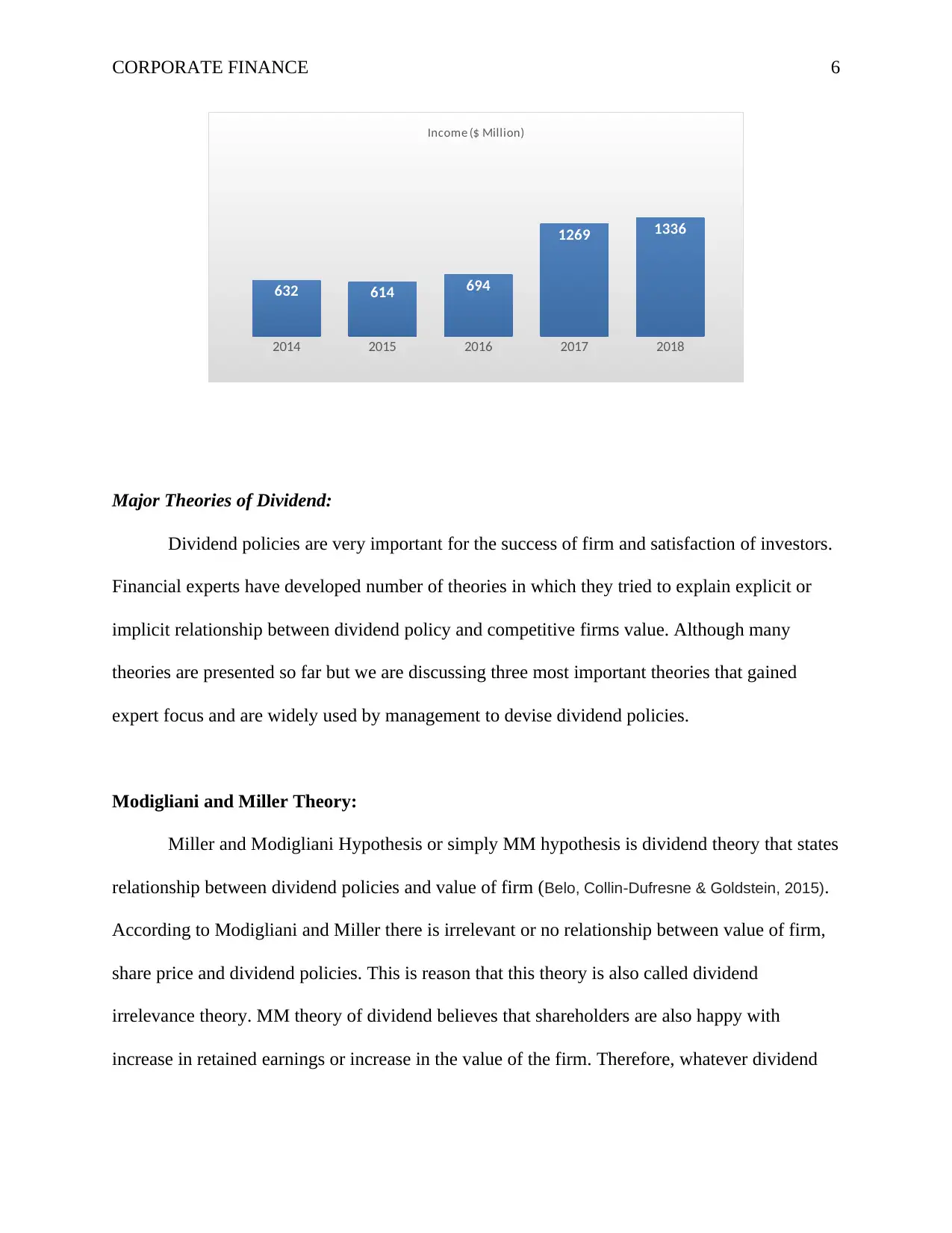
CORPORATE FINANCE 6
2014 2015 2016 2017 2018
632 614 694
1269 1336
Income ($ Million)
Major Theories of Dividend:
Dividend policies are very important for the success of firm and satisfaction of investors.
Financial experts have developed number of theories in which they tried to explain explicit or
implicit relationship between dividend policy and competitive firms value. Although many
theories are presented so far but we are discussing three most important theories that gained
expert focus and are widely used by management to devise dividend policies.
Modigliani and Miller Theory:
Miller and Modigliani Hypothesis or simply MM hypothesis is dividend theory that states
relationship between dividend policies and value of firm (Belo, Collin‐Dufresne & Goldstein, 2015).
According to Modigliani and Miller there is irrelevant or no relationship between value of firm,
share price and dividend policies. This is reason that this theory is also called dividend
irrelevance theory. MM theory of dividend believes that shareholders are also happy with
increase in retained earnings or increase in the value of the firm. Therefore, whatever dividend
2014 2015 2016 2017 2018
632 614 694
1269 1336
Income ($ Million)
Major Theories of Dividend:
Dividend policies are very important for the success of firm and satisfaction of investors.
Financial experts have developed number of theories in which they tried to explain explicit or
implicit relationship between dividend policy and competitive firms value. Although many
theories are presented so far but we are discussing three most important theories that gained
expert focus and are widely used by management to devise dividend policies.
Modigliani and Miller Theory:
Miller and Modigliani Hypothesis or simply MM hypothesis is dividend theory that states
relationship between dividend policies and value of firm (Belo, Collin‐Dufresne & Goldstein, 2015).
According to Modigliani and Miller there is irrelevant or no relationship between value of firm,
share price and dividend policies. This is reason that this theory is also called dividend
irrelevance theory. MM theory of dividend believes that shareholders are also happy with
increase in retained earnings or increase in the value of the firm. Therefore, whatever dividend
⊘ This is a preview!⊘
Do you want full access?
Subscribe today to unlock all pages.

Trusted by 1+ million students worldwide
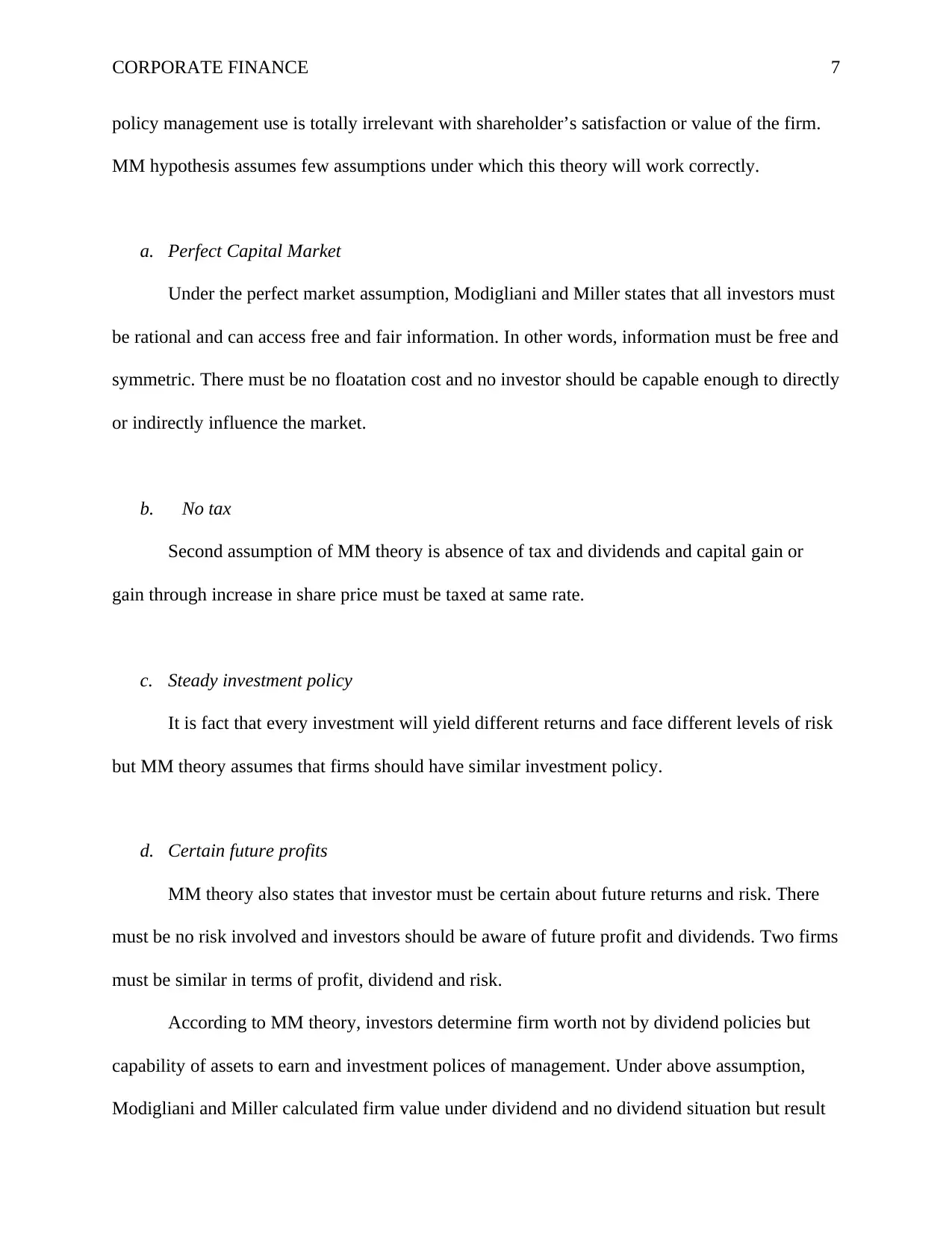
CORPORATE FINANCE 7
policy management use is totally irrelevant with shareholder’s satisfaction or value of the firm.
MM hypothesis assumes few assumptions under which this theory will work correctly.
a. Perfect Capital Market
Under the perfect market assumption, Modigliani and Miller states that all investors must
be rational and can access free and fair information. In other words, information must be free and
symmetric. There must be no floatation cost and no investor should be capable enough to directly
or indirectly influence the market.
b. No tax
Second assumption of MM theory is absence of tax and dividends and capital gain or
gain through increase in share price must be taxed at same rate.
c. Steady investment policy
It is fact that every investment will yield different returns and face different levels of risk
but MM theory assumes that firms should have similar investment policy.
d. Certain future profits
MM theory also states that investor must be certain about future returns and risk. There
must be no risk involved and investors should be aware of future profit and dividends. Two firms
must be similar in terms of profit, dividend and risk.
According to MM theory, investors determine firm worth not by dividend policies but
capability of assets to earn and investment polices of management. Under above assumption,
Modigliani and Miller calculated firm value under dividend and no dividend situation but result
policy management use is totally irrelevant with shareholder’s satisfaction or value of the firm.
MM hypothesis assumes few assumptions under which this theory will work correctly.
a. Perfect Capital Market
Under the perfect market assumption, Modigliani and Miller states that all investors must
be rational and can access free and fair information. In other words, information must be free and
symmetric. There must be no floatation cost and no investor should be capable enough to directly
or indirectly influence the market.
b. No tax
Second assumption of MM theory is absence of tax and dividends and capital gain or
gain through increase in share price must be taxed at same rate.
c. Steady investment policy
It is fact that every investment will yield different returns and face different levels of risk
but MM theory assumes that firms should have similar investment policy.
d. Certain future profits
MM theory also states that investor must be certain about future returns and risk. There
must be no risk involved and investors should be aware of future profit and dividends. Two firms
must be similar in terms of profit, dividend and risk.
According to MM theory, investors determine firm worth not by dividend policies but
capability of assets to earn and investment polices of management. Under above assumption,
Modigliani and Miller calculated firm value under dividend and no dividend situation but result
Paraphrase This Document
Need a fresh take? Get an instant paraphrase of this document with our AI Paraphraser
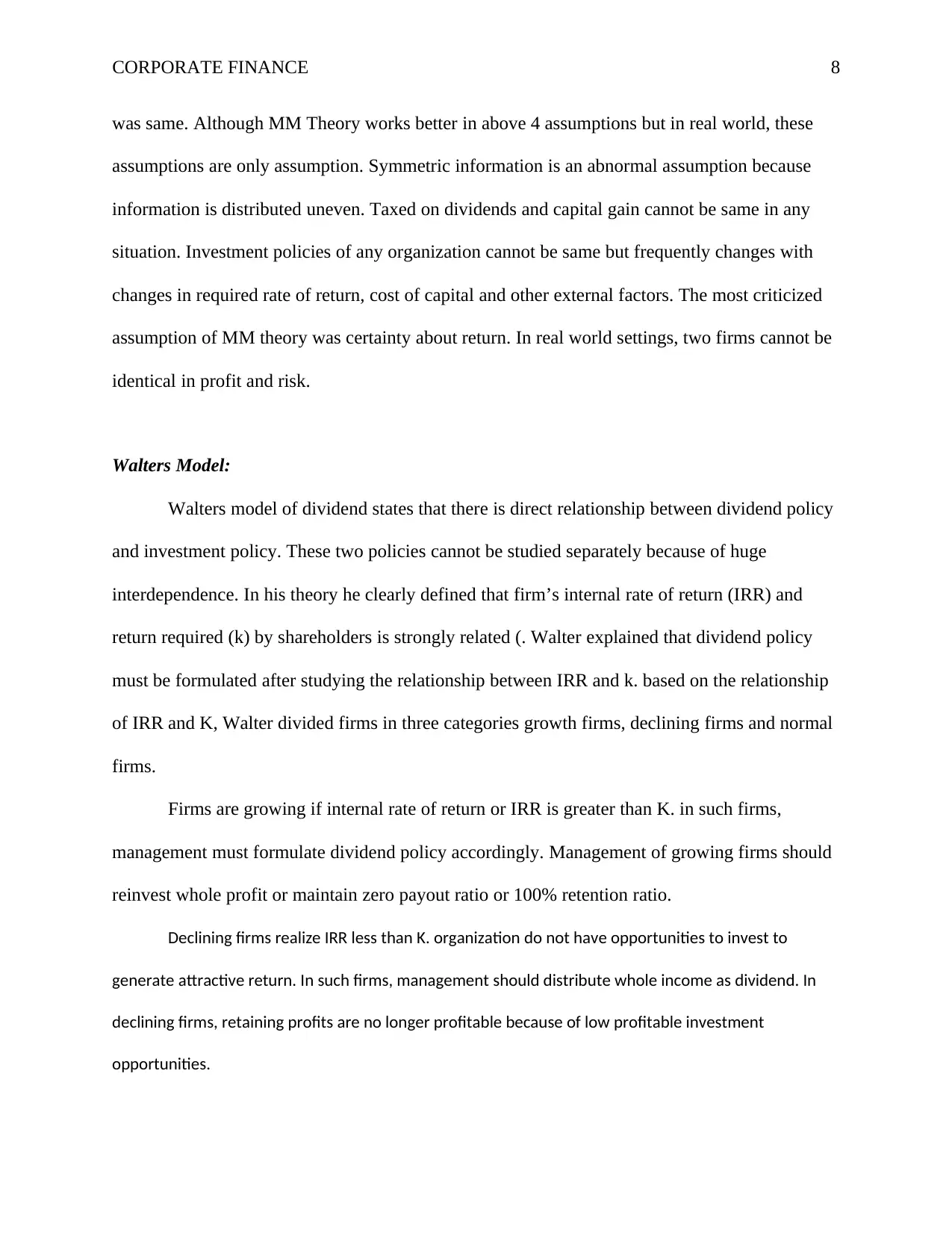
CORPORATE FINANCE 8
was same. Although MM Theory works better in above 4 assumptions but in real world, these
assumptions are only assumption. Symmetric information is an abnormal assumption because
information is distributed uneven. Taxed on dividends and capital gain cannot be same in any
situation. Investment policies of any organization cannot be same but frequently changes with
changes in required rate of return, cost of capital and other external factors. The most criticized
assumption of MM theory was certainty about return. In real world settings, two firms cannot be
identical in profit and risk.
Walters Model:
Walters model of dividend states that there is direct relationship between dividend policy
and investment policy. These two policies cannot be studied separately because of huge
interdependence. In his theory he clearly defined that firm’s internal rate of return (IRR) and
return required (k) by shareholders is strongly related (. Walter explained that dividend policy
must be formulated after studying the relationship between IRR and k. based on the relationship
of IRR and K, Walter divided firms in three categories growth firms, declining firms and normal
firms.
Firms are growing if internal rate of return or IRR is greater than K. in such firms,
management must formulate dividend policy accordingly. Management of growing firms should
reinvest whole profit or maintain zero payout ratio or 100% retention ratio.
Declining firms realize IRR less than K. organization do not have opportunities to invest to
generate attractive return. In such firms, management should distribute whole income as dividend. In
declining firms, retaining profits are no longer profitable because of low profitable investment
opportunities.
was same. Although MM Theory works better in above 4 assumptions but in real world, these
assumptions are only assumption. Symmetric information is an abnormal assumption because
information is distributed uneven. Taxed on dividends and capital gain cannot be same in any
situation. Investment policies of any organization cannot be same but frequently changes with
changes in required rate of return, cost of capital and other external factors. The most criticized
assumption of MM theory was certainty about return. In real world settings, two firms cannot be
identical in profit and risk.
Walters Model:
Walters model of dividend states that there is direct relationship between dividend policy
and investment policy. These two policies cannot be studied separately because of huge
interdependence. In his theory he clearly defined that firm’s internal rate of return (IRR) and
return required (k) by shareholders is strongly related (. Walter explained that dividend policy
must be formulated after studying the relationship between IRR and k. based on the relationship
of IRR and K, Walter divided firms in three categories growth firms, declining firms and normal
firms.
Firms are growing if internal rate of return or IRR is greater than K. in such firms,
management must formulate dividend policy accordingly. Management of growing firms should
reinvest whole profit or maintain zero payout ratio or 100% retention ratio.
Declining firms realize IRR less than K. organization do not have opportunities to invest to
generate attractive return. In such firms, management should distribute whole income as dividend. In
declining firms, retaining profits are no longer profitable because of low profitable investment
opportunities.
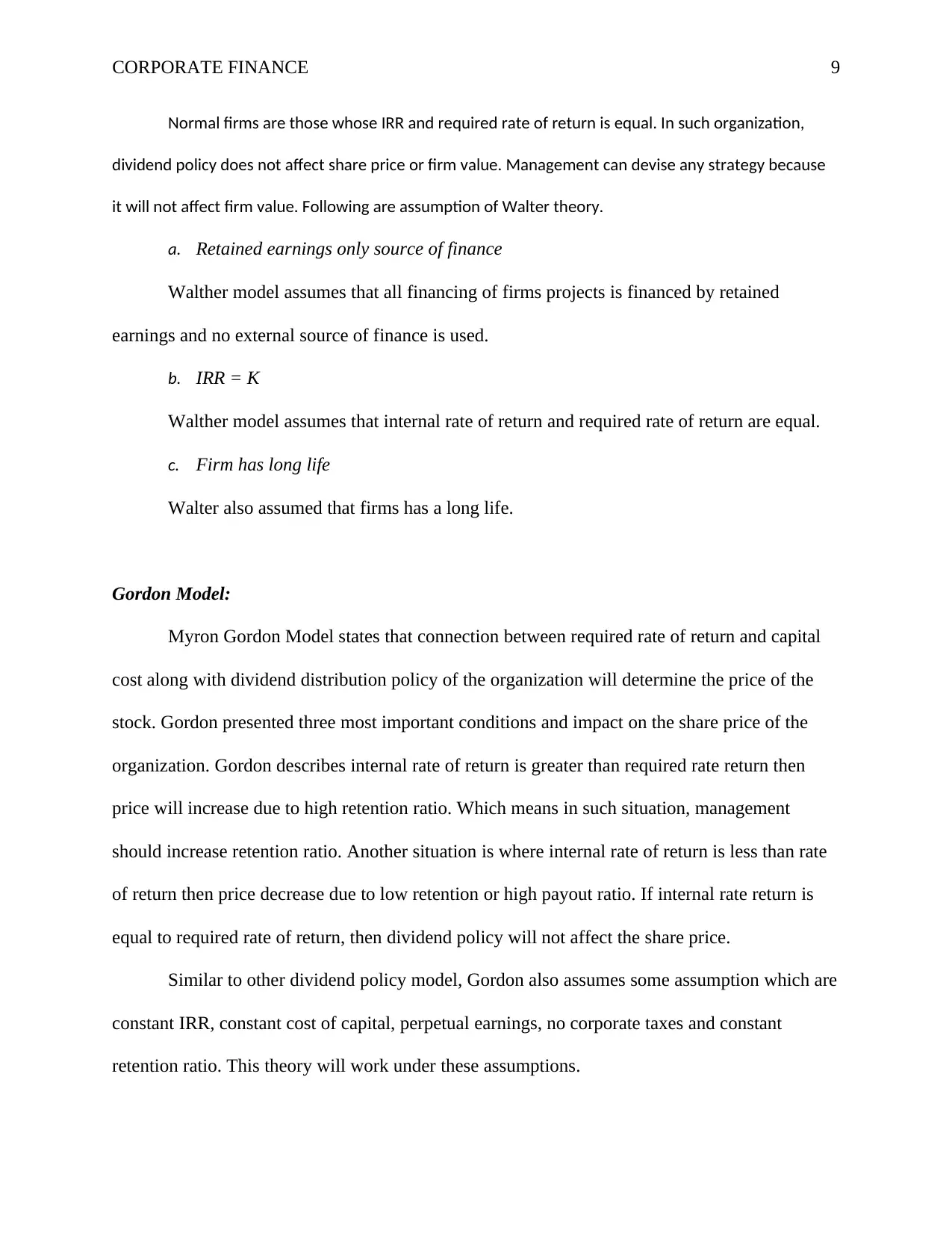
CORPORATE FINANCE 9
Normal firms are those whose IRR and required rate of return is equal. In such organization,
dividend policy does not affect share price or firm value. Management can devise any strategy because
it will not affect firm value. Following are assumption of Walter theory.
a. Retained earnings only source of finance
Walther model assumes that all financing of firms projects is financed by retained
earnings and no external source of finance is used.
b. IRR = K
Walther model assumes that internal rate of return and required rate of return are equal.
c. Firm has long life
Walter also assumed that firms has a long life.
Gordon Model:
Myron Gordon Model states that connection between required rate of return and capital
cost along with dividend distribution policy of the organization will determine the price of the
stock. Gordon presented three most important conditions and impact on the share price of the
organization. Gordon describes internal rate of return is greater than required rate return then
price will increase due to high retention ratio. Which means in such situation, management
should increase retention ratio. Another situation is where internal rate of return is less than rate
of return then price decrease due to low retention or high payout ratio. If internal rate return is
equal to required rate of return, then dividend policy will not affect the share price.
Similar to other dividend policy model, Gordon also assumes some assumption which are
constant IRR, constant cost of capital, perpetual earnings, no corporate taxes and constant
retention ratio. This theory will work under these assumptions.
Normal firms are those whose IRR and required rate of return is equal. In such organization,
dividend policy does not affect share price or firm value. Management can devise any strategy because
it will not affect firm value. Following are assumption of Walter theory.
a. Retained earnings only source of finance
Walther model assumes that all financing of firms projects is financed by retained
earnings and no external source of finance is used.
b. IRR = K
Walther model assumes that internal rate of return and required rate of return are equal.
c. Firm has long life
Walter also assumed that firms has a long life.
Gordon Model:
Myron Gordon Model states that connection between required rate of return and capital
cost along with dividend distribution policy of the organization will determine the price of the
stock. Gordon presented three most important conditions and impact on the share price of the
organization. Gordon describes internal rate of return is greater than required rate return then
price will increase due to high retention ratio. Which means in such situation, management
should increase retention ratio. Another situation is where internal rate of return is less than rate
of return then price decrease due to low retention or high payout ratio. If internal rate return is
equal to required rate of return, then dividend policy will not affect the share price.
Similar to other dividend policy model, Gordon also assumes some assumption which are
constant IRR, constant cost of capital, perpetual earnings, no corporate taxes and constant
retention ratio. This theory will work under these assumptions.
⊘ This is a preview!⊘
Do you want full access?
Subscribe today to unlock all pages.

Trusted by 1+ million students worldwide
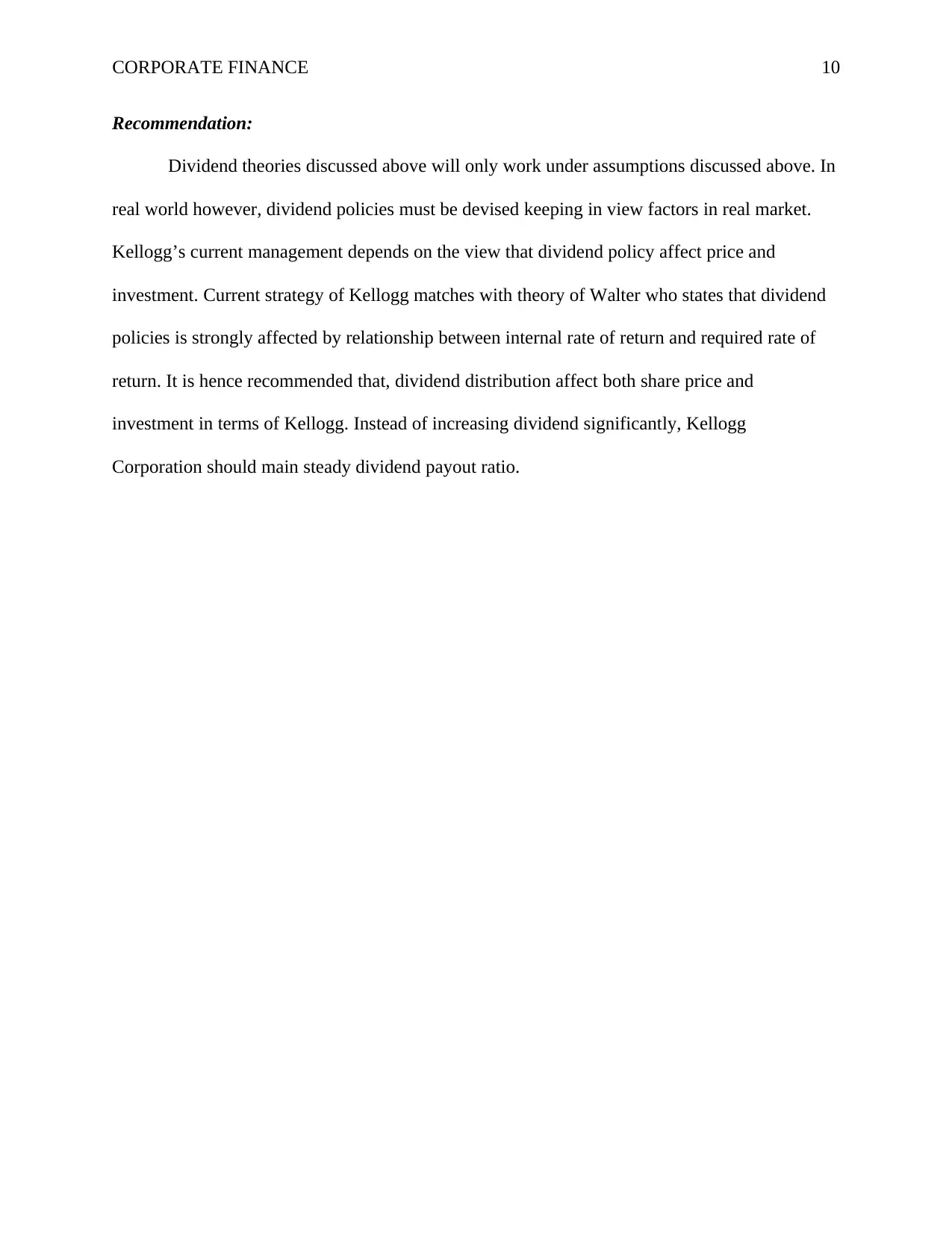
CORPORATE FINANCE 10
Recommendation:
Dividend theories discussed above will only work under assumptions discussed above. In
real world however, dividend policies must be devised keeping in view factors in real market.
Kellogg’s current management depends on the view that dividend policy affect price and
investment. Current strategy of Kellogg matches with theory of Walter who states that dividend
policies is strongly affected by relationship between internal rate of return and required rate of
return. It is hence recommended that, dividend distribution affect both share price and
investment in terms of Kellogg. Instead of increasing dividend significantly, Kellogg
Corporation should main steady dividend payout ratio.
Recommendation:
Dividend theories discussed above will only work under assumptions discussed above. In
real world however, dividend policies must be devised keeping in view factors in real market.
Kellogg’s current management depends on the view that dividend policy affect price and
investment. Current strategy of Kellogg matches with theory of Walter who states that dividend
policies is strongly affected by relationship between internal rate of return and required rate of
return. It is hence recommended that, dividend distribution affect both share price and
investment in terms of Kellogg. Instead of increasing dividend significantly, Kellogg
Corporation should main steady dividend payout ratio.
Paraphrase This Document
Need a fresh take? Get an instant paraphrase of this document with our AI Paraphraser
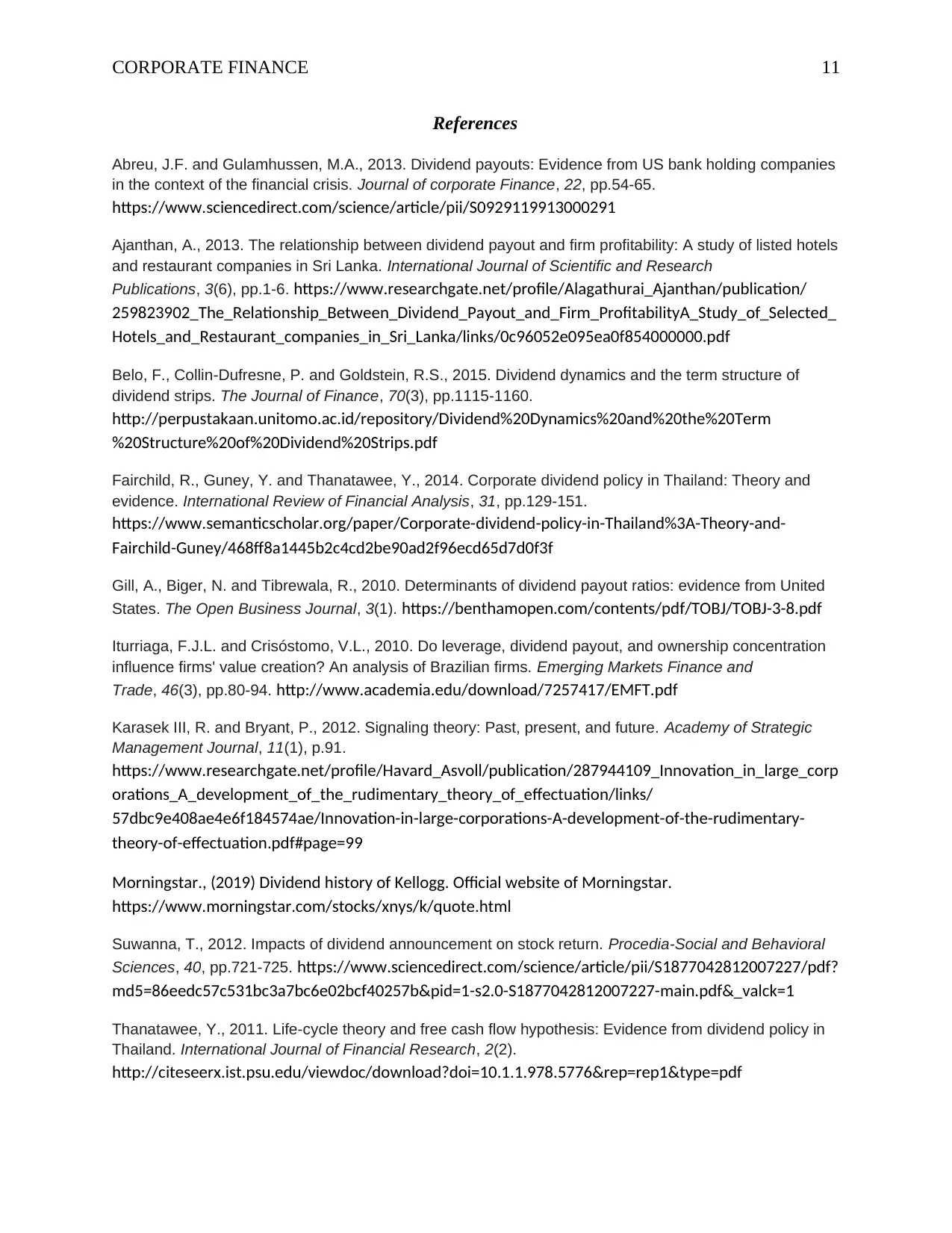
CORPORATE FINANCE 11
References
Abreu, J.F. and Gulamhussen, M.A., 2013. Dividend payouts: Evidence from US bank holding companies
in the context of the financial crisis. Journal of corporate Finance, 22, pp.54-65.
https://www.sciencedirect.com/science/article/pii/S0929119913000291
Ajanthan, A., 2013. The relationship between dividend payout and firm profitability: A study of listed hotels
and restaurant companies in Sri Lanka. International Journal of Scientific and Research
Publications, 3(6), pp.1-6. https://www.researchgate.net/profile/Alagathurai_Ajanthan/publication/
259823902_The_Relationship_Between_Dividend_Payout_and_Firm_ProfitabilityA_Study_of_Selected_
Hotels_and_Restaurant_companies_in_Sri_Lanka/links/0c96052e095ea0f854000000.pdf
Belo, F., Collin‐Dufresne, P. and Goldstein, R.S., 2015. Dividend dynamics and the term structure of
dividend strips. The Journal of Finance, 70(3), pp.1115-1160.
http://perpustakaan.unitomo.ac.id/repository/Dividend%20Dynamics%20and%20the%20Term
%20Structure%20of%20Dividend%20Strips.pdf
Fairchild, R., Guney, Y. and Thanatawee, Y., 2014. Corporate dividend policy in Thailand: Theory and
evidence. International Review of Financial Analysis, 31, pp.129-151.
https://www.semanticscholar.org/paper/Corporate-dividend-policy-in-Thailand%3A-Theory-and-
Fairchild-Guney/468ff8a1445b2c4cd2be90ad2f96ecd65d7d0f3f
Gill, A., Biger, N. and Tibrewala, R., 2010. Determinants of dividend payout ratios: evidence from United
States. The Open Business Journal, 3(1). https://benthamopen.com/contents/pdf/TOBJ/TOBJ-3-8.pdf
Iturriaga, F.J.L. and Crisóstomo, V.L., 2010. Do leverage, dividend payout, and ownership concentration
influence firms' value creation? An analysis of Brazilian firms. Emerging Markets Finance and
Trade, 46(3), pp.80-94. http://www.academia.edu/download/7257417/EMFT.pdf
Karasek III, R. and Bryant, P., 2012. Signaling theory: Past, present, and future. Academy of Strategic
Management Journal, 11(1), p.91.
https://www.researchgate.net/profile/Havard_Asvoll/publication/287944109_Innovation_in_large_corp
orations_A_development_of_the_rudimentary_theory_of_effectuation/links/
57dbc9e408ae4e6f184574ae/Innovation-in-large-corporations-A-development-of-the-rudimentary-
theory-of-effectuation.pdf#page=99
Morningstar., (2019) Dividend history of Kellogg. Official website of Morningstar.
https://www.morningstar.com/stocks/xnys/k/quote.html
Suwanna, T., 2012. Impacts of dividend announcement on stock return. Procedia-Social and Behavioral
Sciences, 40, pp.721-725. https://www.sciencedirect.com/science/article/pii/S1877042812007227/pdf?
md5=86eedc57c531bc3a7bc6e02bcf40257b&pid=1-s2.0-S1877042812007227-main.pdf&_valck=1
Thanatawee, Y., 2011. Life-cycle theory and free cash flow hypothesis: Evidence from dividend policy in
Thailand. International Journal of Financial Research, 2(2).
http://citeseerx.ist.psu.edu/viewdoc/download?doi=10.1.1.978.5776&rep=rep1&type=pdf
References
Abreu, J.F. and Gulamhussen, M.A., 2013. Dividend payouts: Evidence from US bank holding companies
in the context of the financial crisis. Journal of corporate Finance, 22, pp.54-65.
https://www.sciencedirect.com/science/article/pii/S0929119913000291
Ajanthan, A., 2013. The relationship between dividend payout and firm profitability: A study of listed hotels
and restaurant companies in Sri Lanka. International Journal of Scientific and Research
Publications, 3(6), pp.1-6. https://www.researchgate.net/profile/Alagathurai_Ajanthan/publication/
259823902_The_Relationship_Between_Dividend_Payout_and_Firm_ProfitabilityA_Study_of_Selected_
Hotels_and_Restaurant_companies_in_Sri_Lanka/links/0c96052e095ea0f854000000.pdf
Belo, F., Collin‐Dufresne, P. and Goldstein, R.S., 2015. Dividend dynamics and the term structure of
dividend strips. The Journal of Finance, 70(3), pp.1115-1160.
http://perpustakaan.unitomo.ac.id/repository/Dividend%20Dynamics%20and%20the%20Term
%20Structure%20of%20Dividend%20Strips.pdf
Fairchild, R., Guney, Y. and Thanatawee, Y., 2014. Corporate dividend policy in Thailand: Theory and
evidence. International Review of Financial Analysis, 31, pp.129-151.
https://www.semanticscholar.org/paper/Corporate-dividend-policy-in-Thailand%3A-Theory-and-
Fairchild-Guney/468ff8a1445b2c4cd2be90ad2f96ecd65d7d0f3f
Gill, A., Biger, N. and Tibrewala, R., 2010. Determinants of dividend payout ratios: evidence from United
States. The Open Business Journal, 3(1). https://benthamopen.com/contents/pdf/TOBJ/TOBJ-3-8.pdf
Iturriaga, F.J.L. and Crisóstomo, V.L., 2010. Do leverage, dividend payout, and ownership concentration
influence firms' value creation? An analysis of Brazilian firms. Emerging Markets Finance and
Trade, 46(3), pp.80-94. http://www.academia.edu/download/7257417/EMFT.pdf
Karasek III, R. and Bryant, P., 2012. Signaling theory: Past, present, and future. Academy of Strategic
Management Journal, 11(1), p.91.
https://www.researchgate.net/profile/Havard_Asvoll/publication/287944109_Innovation_in_large_corp
orations_A_development_of_the_rudimentary_theory_of_effectuation/links/
57dbc9e408ae4e6f184574ae/Innovation-in-large-corporations-A-development-of-the-rudimentary-
theory-of-effectuation.pdf#page=99
Morningstar., (2019) Dividend history of Kellogg. Official website of Morningstar.
https://www.morningstar.com/stocks/xnys/k/quote.html
Suwanna, T., 2012. Impacts of dividend announcement on stock return. Procedia-Social and Behavioral
Sciences, 40, pp.721-725. https://www.sciencedirect.com/science/article/pii/S1877042812007227/pdf?
md5=86eedc57c531bc3a7bc6e02bcf40257b&pid=1-s2.0-S1877042812007227-main.pdf&_valck=1
Thanatawee, Y., 2011. Life-cycle theory and free cash flow hypothesis: Evidence from dividend policy in
Thailand. International Journal of Financial Research, 2(2).
http://citeseerx.ist.psu.edu/viewdoc/download?doi=10.1.1.978.5776&rep=rep1&type=pdf
1 out of 11
Related Documents
Your All-in-One AI-Powered Toolkit for Academic Success.
+13062052269
info@desklib.com
Available 24*7 on WhatsApp / Email
![[object Object]](/_next/static/media/star-bottom.7253800d.svg)
Unlock your academic potential
Copyright © 2020–2026 A2Z Services. All Rights Reserved. Developed and managed by ZUCOL.





